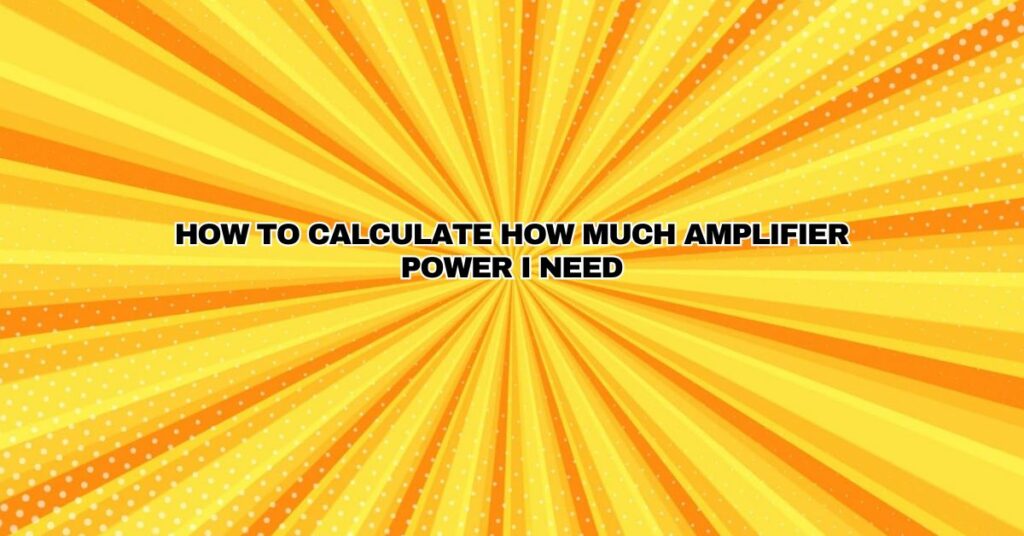Selecting the appropriate amplifier power for your audio system is crucial in achieving the desired sound quality and volume. Underpowering your speakers can result in distortion and potential damage, while overdoing it can be wasteful and costly. So, how do you calculate how much amplifier power you need? In this comprehensive article, we’ll guide you through the steps to determine the right amplifier wattage for your specific setup, considering factors like speaker sensitivity, room size, and intended application.
Understanding Amplifier Power Ratings
Before delving into calculations, it’s essential to understand amplifier power ratings. Amplifier power is typically expressed in Watts (W) and refers to the amount of electrical power the amplifier can deliver to drive your speakers. The matching of amplifier power to your speakers is critical to ensure optimal performance.
Factors Affecting Power Requirements
Several factors influence the amount of amplifier power you need:
- Speaker Sensitivity: Speaker sensitivity, measured in decibels (dB), indicates how efficiently a speaker converts electrical power into sound. A more sensitive speaker requires less amplifier power to achieve a specific volume level.
- Room Size: The physical dimensions of the room in which you’ll be using your audio system play a significant role. Smaller rooms require less power to fill with sound, while larger venues demand more wattage.
- Intended Application: The purpose of your sound system affects power requirements. Home audio, studio monitoring, live performances, and large venues all have distinct demands.
- Music Genre: Different music genres may require varying power levels. Rock or heavy metal music, for example, often requires more power for high volume and distortion.
Calculating Amplifier Power Requirements
- Determine Speaker Sensitivity: Find out the sensitivity rating of your speakers. This information is usually available in the product specifications. Sensitivity is measured in dB at 1 meter with 1 Watt of input power.
- Estimate Required Sound Pressure Level (SPL): Decide how loud you want your audio system to be. This level is often measured in decibels (dB) and depends on the specific application. For instance, home listening may require around 85-95dB SPL, while live performances in small venues might demand 100-110dB SPL.
- Use the Inverse Square Law: Remember that sound follows the inverse square law, meaning that doubling the distance from the speaker decreases sound intensity by a factor of four. Take this into account when estimating required SPL.
- Calculate Required Amplifier Power: You can use the following formula to calculate the amplifier power needed:
Amplifier Power (Watts) = (Desired SPL – Speaker Sensitivity + 10 * log10(Room Size in Cubic Feet))
The “+10 * log10(Room Size in Cubic Feet)” term accounts for the room’s influence on sound dispersion.
Practical Examples
Let’s consider a few practical examples:
- Home Audio Setup: If you have speakers with 90dB sensitivity and aim for 90dB SPL in a 200 square foot room, the required amplifier power is roughly 1-2 Watts.
- Studio Monitoring: For near-field studio monitoring with 87dB sensitivity speakers and a target SPL of 85dB in a 150 square foot room, you’d need an amplifier delivering around 15-20 Watts.
- Small Venue Performance: In a small venue with 100dB sensitivity speakers, aiming for 105dB SPL in a 1000 square foot room, the amplifier power requirement might be around 100 Watts.
Conclusion
Calculating how much amplifier power you need is a crucial step in creating a well-balanced audio system. By considering factors such as speaker sensitivity, room size, intended application, and desired volume levels, you can make an informed decision about the appropriate amplifier wattage. Selecting the right amplifier power ensures your speakers perform optimally, delivering clean and undistorted sound while preserving their longevity. Whether you’re setting up a home audio system, recording in a studio, or performing on stage, finding the correct power for your setup is the key to achieving the best audio quality and ensuring your music is heard as intended.

